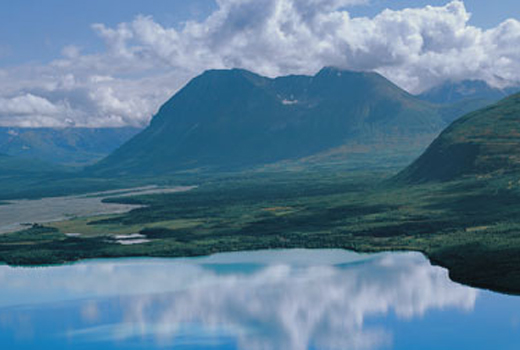Legislation and the Land: Understanding the Effects Upon Southwest Alaska
For more than 9,000 years the natives of Alaska have been stewards to one of the most incredible ecosystems on the planet. Living harmoniously with the land, they have maintained a subsistence lifestyle that has protected their diverse habitat. For generations the indigenous peoples have supported themselves with a sustainable economy by relying upon a rich, renewable resource the salmon population to continue their way of life. Torn between the desire to preserve their culturally rich heritage and the need to keep up with Western society economics, the people of Southwest Alaska are divided on the fate of their area. Hailed as “the greatest con servation challenge facing North America,” the outcome lies not only in the hands of elected state and national officials, but also in the hands of the people brave enough to dedicate themselves to the preservation of America’s last great wilderness.
Now more than ever politicians are emphasizing the need for America to wean itself off foreign resources. Mineral rich Alaska is again a main focus not only for politicians but also for companies looking to “make a quick buck” at the environment’s expense. “The nation’s appetite to use more natural resources is causing a lot of problems for us,” explains Ralph Anderson of the Bristol Bay Native Association (BBNA). As a result, people of Southwest Alaska, particularly of the Bristol Bay region, are facing critical challenges with the discovery of land considered to be a world class copper and gold reserve. The crux of the problem is the proposed Pebble Mine location at the headwaters of the world’s two most incredible fisheries (see livebetter’s Jan./Feb. ’08 issue).
At the state level two bills have been introduced to protect this fragile ecosystem and essentially to halt the prospect of Pebble Mine production. In January 2007, Senate Bill 67, also known as “The Jay Hammond State Game Refuge proposal,” was introduced by Senate Majority Leader Gary Stevens, R Kodiak, AK. Should this bill pass, not only would it protect the salmon, trout, caribou, brown bear and other species in a new game refuge on state lands between the Kvichak and Nushagak Mulchatna River drainages, but it would also ban storage of industrial waste and pollution discharges that do not meet water quality requirements for fish. Hunting and fishing would be allowed, but staking any new mineral claims inside the refuge would be prohibited.
Dillingham, AK legislator Democrat Rep. Bryce Edgmon introduced similar leg islation, House Bill 134, also known as the “Alaska Wild Salmon Protection Act.” This bill would prevent anyone from diverting or polluting water that runs into five rivers the Nushagak, Kvichak, Naknek, Egegik and Ugashik that nourish Bristol Bay’s fisheries. Two of these rivers are near the Pebble deposit. The proposed bill would block anyone from damming salmon bearing water bodies within the five river drainages. The penalty for violating the proposed law: $10 to $5,000 per day for an individual and $100,000 to $1 million per day for a corporation. Of course, until Canadian based Northern Dynasty proposes a development plan, it’s difficult to determine potential environmental consequences. Many now predict it may well be 2009 before Northern Dynasty announces its Pebble Mine proposal.
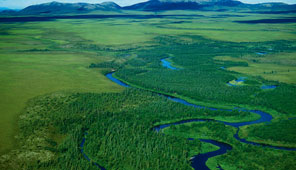
© Robert Glenn Ketchum
While most would expect the natives to be united in support of proposed legislation and against the Pebble Mine, the reality is that the complex conflict has split some families down the middle. According to Anderson, the biggest challenge is improv ing the economy by creating jobs in the region while protecting the traditional subsistence resources and lifestyle of the natives. Life in Alaska is not the same as in the lower 48 states; by all accounts it is much harsher and less forgivable. The majority of Alaskan natives concentrate on obtaining the necessities of life not on accumulating material wealth. In a subsis tence lifestyle the concept of materialism does not exist so only minimal surpluses are created; therefore, a reliance on renewable resources within the natural environment is critical to survival.
With gas costing up to $5 per gallon and some villages paying as much as $10 per gallon for heating fuel, the natives’ tradi tional lifestyle is in jeopardy. “We can’t live a minute in our villages without cash,” ex plains Anderson. To help alleviate the strain of “trying to make ends meet,” the BBNA, with the help of CITGO, has implemented a fuel program to provide 100 gallons of free oil to each native. Many are taking advantage of the program, but some of the more conservative tribes consider the offer unpatriotic and call it “devil oil.”
Economic decline, cost of energy and lack of jobs are forcing many area residents to believe the benefits of tapping into the region’s mineral resources would help boost the economy. Should a proposal such as Pebble Mine go into production, questions will still remain: “Who is actually going to be employed? Will there be any skill build ing or training for the natives as a long term economic benefit to the region?” Danny Consenstein of the Renewable Resources Coalition (RRC) says, “The people they bring in to run the mine the engineers, geologists they probably won’t even come from Alaska.”
In Northern Alaska the Red Dog Mine experienced this phenomenon. Located in the Northwest Arctic Borough, the mine is the world’s largest source of zinc while pos sessing a significant source of lead. At first the Red Dog Mine did hire locals; but after they obtained the jobs, most moved away because of the two weeks on, one week off work schedule. While many natives benefit economically from the mine, they still de pend on a healthy environment. The latter is increasingly problematic because, according to the Environmental Protection Agency (EPA), the Red Dog Mine releases more toxic waste than any other operation in the United States.
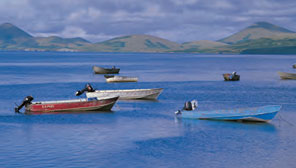
© Robert Glenn Ketchum
Bristol Bay residents fear the same outcome if Pebble Mine becomes a reality. Obviously no one in the region is opposed to jobs, but many believe one resource should not be sacrificed for another. Ac cording to Consenstein, economic studies show that 6,300 jobs depend on the wild salmon which, in turn, depend on protec tion of their habitat. “If you take care of the salmon and what they need to survive, you can continue to have those jobs for generations. That’s the difference between sustainable jobs and non sustainable jobs,” he explains. When Northern Dynasty told Luki Akelkok, a Native elder from Ekwok, they could provide jobs for his people for the next 50 years, he replied, “That’s great, but what about after that?”
Is a short term boom from mining’s busy resource extraction worth destroying the sustainability of a resource that Bristol Bay natives have relied upon for more than 9,000 years? To evaluate this properly, it is important to first grasp the massive scale of the Pebble Project, once fully developed. Pebble Mine is, in itself, physically burden some with its proposed open pit stretching up to two miles long and several thousand feet deep. Then consider the 1,000 square miles of mining claims surrounding the actual Pebble deposit. After establishing the infrastructure, which includes a 100 mile access road, essentially a city for the workers, a power plant, power lines and slurry pipes, the next question is access to power for the plant.
The mine at full production, in theory, would use as much power as Anchorage, the biggest city in Alaska with 250,000 residents. Experts posit, from all available informa tion, that Northern Dynasty will obtain power from coal, which would require a probable strip mine to extract the coal, a gasification plant to process the coal and a journey to the mine fill. This, in itself, would change the economics of some smaller mineral deposits making Pebble Mine one of the largest mining districts on the planet. In addition to creating extremely difficult environmental monitoring require ments, toxic waste would remain in dams permanently situated in a geologically unstable location at the headwaters of Bristol Bay; the largest of these dams is projected to be taller than the Hoover or Grand Coulee Dams.
Many believe the answer to Southwest Alaska’s economic crisis lies in its already abundant supply of the region’s No. 1 resource, fish. “Before we throw the baby out with the bathwater and build the largest open pit sulfide bearing mine in North America, maybe we should try to figure out ways to maximize our fisheries resource,” says Tim Bristol of Trout Unlimited (TU) (www.tu.org), an organization aimed at conserving, protecting and restoring North America’s cold water fisheries and their watersheds. “People could easily help locals receive more money for their fish,” Bristol says. To that end, TU has developed its “Vote with Your Fork” campaign, which is delivering Alaska’s renowned fresh sockeye salmon into new fish markets such as the New Seasons Market in Portland, OR. The campaign, still in its early stages, is uniting ild salmon harvesters and processors with aring consumers willing not only to pay op dollar for the fish but also willing to ke the extra step to write Congress to emand the long term viability of this xceptionally nutritious food source.
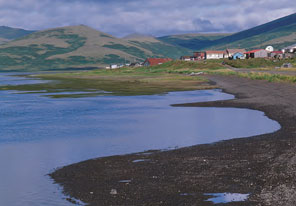
© Robert Glenn Ketchum
“The Alaskan sport fishing industry has been underrepresented as well in regard to it’s contributions as far as the local, regional and state economy,” Bristol points out. TU has reports that show $60 million-$100 million annually from the sport fishing industry alone. People travel to Bristol Bay and spend large amounts of money for the privilege of catching salmon or trout. According to Bristol, some of the best rainbow trout fishing on the planet is in Bristol Bay, which is why people come from all over the world.
TU, along with Felt Soul Media, an award winning producer of fly fishing films, will reveal the beauty and bounty of the pristine Bristol Bay watershed in a docu mentary titled Red Gold. Upon completion Felt Soul Media and TU Alaska plan to take Red Gold on the road. They will show it at public venues throughout Alaska and in the lower 48 states while also submitting it to film festivals throughout the world. This project will give a voice to the commercial, sport and subsistence fishermen who are united against the face of mining develop ment and the proposed Pebble Mine.
Many other non profits, such as RRC, are actively fighting to support sustainable industry in the Bristol Bay Region, which is already being threatened by Northern Dynasty’s preliminary planning. According to Consenstein, “The caribou and moose are already moving out because of all the helicopters flying around.” For an indige nous people who depend on the land for everything, this could easily become a life or death situation. That’s why RRC, other groups and individuals have been working to get an initiative on the ballot. It is sponsored by three local gentlemen: two natives and one lodge owner. The proposal, the Clean Water Initiative, asks Alaskan voters to decide on new restrictions for large scale mineral mines to prevent the discharge of pollutants into water used for drinking or for salmon habitat. In just the last two months of 2007, 30,000 signatures were collected, a feat never before accomplished. “When these signatures hit the desk, the legislature is going to feel that,” says Consenstein. The initiative will likely be on the August primary ballot; however, there is some chance that it will be on the November general election ballot.
Many people hope Pebble Mine will never go into production; regardless, a main conflict still exists. The people of Southwest Alaska are still wondering how they are going to improve their economy. Ralph Anderson of the BBNA would like to help solve this problem with a federal bill titled “The Native American Challenge Demonstration Project of 2007,” HR 3351. This proposed legislation, introduced on both sides of Congress, is a five year pro gram aimed at reducing poverty in two re gions with Bristol Bay being one of them. BBNA is hoping the bill will gain traction in 2008.
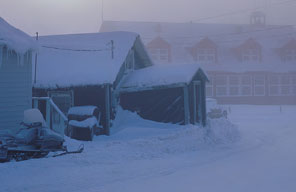
© Robert Glenn Ketchum
Unfortunately, other controversial legislation has already passed, and it’s causing anxiety for Southwest Alaska’s indigenous peoples. After President Bush lifted the ban on offshore oil and gas drilling in January 2007, fragile waters off the coast of Bristol Bay were left unprotected for the first time since the Exxon Valdez spill in 1989. Soon after the restriction was lifted, the Minerals Management Service finalized its Outer Continental Shelf (OCS) five year Plan for Oil and Gas Leasing 2007 2012. In response, Rep. Jay Inslee (D WA) introduced H.R. 1957, known as the Bristol Bay Protection Act, to Congress. In addition Sen. John Kerry (D MA) introduced S. 1311, which is identical to H.R. 1957. This legislation would permanently protect the salmon rich waters of Bristol Bay from oil and gas leasing. Both bills are still in the first stages of the legislative process and have been referred to the Sub Committee on Energy and Mineral Resources.
For people who know Alaska, the irony is evident when reflecting upon the com plex issues surrounding the region’s distribution of natural resources and the natives’ ability to access these resources to improve their quality of life. “Take a look at Alaska; we’re one of the leading oil producers in the nation, yet we’re still paying these outrageous prices for fuel,” explains Anderson.
In the Bristol Bay region, electricity is usually generated by diesel fuel and oil is used to heat homes. Gas is essential in conducting native hunting activity. As a result, utilization of fuel technology is a major issue among the natives. Many, including Consenstein, believe that developing more innovative forms of energy could create jobs and could reduce residents’ painfully high energy costs.
For America the issues surrounding Southwest Alaska require us to finally address the fundamental questions of how to balance the economy with the environ ment while providing equity and justice for its Native Alaskans. When are we, as Americans, finally going to draw the line? Are we going to pride ourselves on having places like Bristol Bay and, in the process, support the indigenous owners and stewards of the greatest remaining salmon fishery in the world? Or are we just going to let it unravel by selling off America’s last great wilderness while selling out Native Alaskans one of the world’s oldest peoples and, arguably, America’s wisest and most unique living legacy. The bottom line is that it’s “gut check time” not only for the state of Alaska but also for the entire United States (especially every person of voting age).
Seize the opportunity to make a difference; make the world a better place for everyone. In the end, you’ll be making a better world for yourself and for your family.

